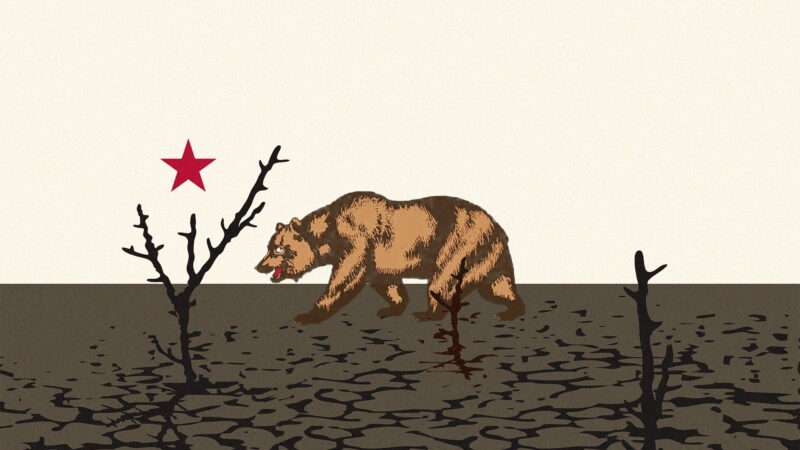
After returning from a recent trip to the rainy Pacific Northwest, I opened the faucet and instead of hearing rushing water, I heard only the dreadful coughing sound one gets from empty pipes. Fortunately, my well hadn't gone dry, but some mechanical part in the pump had given out.
Still, few things are as frightening as running out of water. Our well was running in 24 hours, but that was a long day of using bottled water and rationing the use of toilets. It reminded me of the disaster that awaits if California can't fix its shortages before it rains again. By the way, it was creepy driving past Mt. Shasta and noticing its non-existent snowpack.
The state always has been plagued by alternating droughts and floods. "California summers were characterized by the coughing in the pipes that meant the well was dry, and California winters by all-night watches on rivers about to crest," wrote Joan Didion in her 1977 essay, "Holy Water." Living near California's last undammed river, I've spent long nights watching the Cosumnes overcome the aging levees.
Counterintuitive as it sounds, policymakers spend too much time worrying about how much water Californians use to run their households—and too little time figuring out how to bring more water into our system. The state hasn't built significant water infrastructure since Didion penned that essay—when the state had 17.6-million fewer residents.
Five years ago, Jerry Brown announced the official end of a grueling six-year drought. Other than passing resolutions to "make conservation a way of life," the former governor didn't do much to improve the situation. After rains resumed, interest waned in fixing our water supply issues.
These days, the Newsom administration and Legislature have done little more than engage in water shaming. They want to badger us into using less water, as the state imposes tougher water-use standards on water districts and some districts (especially in the Bay Area) embrace water rationing.
Conservation is, of course, a good idea—and local districts that manage depleted reservoirs perhaps have no choice but to issue water-use edicts. But there's a better way forward than encouraging people to report their water-wasting neighbors to the authorities.
"Since the drought emergency was declared in July 2021, Californians have reduced water usage by 2 percent, far below (Newsom's) goal of 15 percent," The Los Angeles Times reported this month. "You're not saving enough water, Southern California," blared a July Orange County Register article noting that, "draconian measures may be coming to stop folks from watering all those begonias."
Begonias aren't the problem. Californians and other residents of the parched Western states have indeed been conserving water. It is a way of life and has been for years. In the 1990s, Californians used around 200 gallons per capita per day (down from 220 in the 1980s), but now use around 48 gallons per capita per day—below the statewide standard of 55.
My favorite statistic comes from far drier Arizona, where Arizonans use less total water than they did in 1957—when that state had one-seventh of its current population. There's no need to shame Westerners for their water usage, but there is reason to shame our officials for not doing their part to upgrade and build new water infrastructure.
Newsom was elected in 2018, and only this week did he reveal his plan for the Delta tunnel. "After three years with little to no public activity, the state released an environmental blueprint for…a 45-mile tunnel that would divert water from the Sacramento River and route it under the Sacramento-San Joaquin Delta so that it can be shipped to farms and cities," The Sacramento Bee reported.
The now-single tunnel proposal will not provide more water, but will assure more reliable deliveries. The Sacramento River flows into the Delta, where it gets mired in hundreds of miles of waterways before the water is pumped southward. Administrators frequently shutter the pumps when a Delta smelt is found in the fish screens.
Environmentalists are aghast at the plan. They predict an environmental catastrophe, yet currently—thanks to saltwater intrusion from the Pacific Ocean and subsidence (sinking land)—that beautiful region is suffering from a slow-motion environmental mess. The plan will also fund habitat restoration.
Where are the plans to bolster our water-storage capacities? Why can't California prepare for the future? Recently, the California Coastal Commission rejected a desalination plant that would have met 12 percent of Orange County's water needs. Newsom supported it, but didn't expend much political capital to assure its approval.
California has a $97.5-billion surplus. Now's the time to invest in water facilities, but instead the administration is squandering money on other things—and then blaming us for watering the begonias. Households use only 5.7 percent of our available water, so when your pipes start coughing, don't blame yourself. Blame the state's leaders.
This column was first published at The Orange County Register.
The post California's Drought Is an Infrastructure Problem appeared first on Reason.com.







